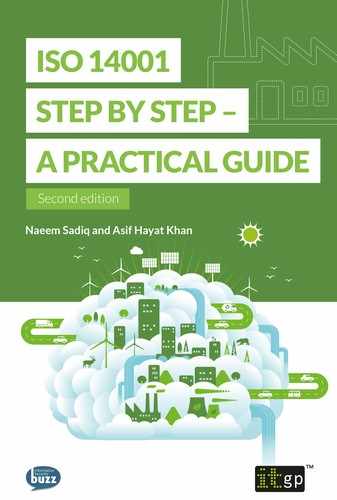CHAPTER 3: REGULATORY REQUIREMENTS AND EVALUATING COMPLIANCE (CLAUSES 6.1.3 AND 9.1.2)
Summary of requirements
Establish and implement a system that:
• Defines the process of identifying and accessing applicable requirements (relating to its environmental aspects);
• Determines how those requirements apply;
• Considers these requirements while establishing and implementing the EMS; and
• Periodically verifies the organisation’s continued compliance with these requirements.
How can these requirements be met?
The first step in managing compliance with environmental legal requirements is to know which requirements apply to the environmental aspects of an organisation’s activities, products and services.
Each country has its own environmental laws and regulatory bodies. The three environmental regulators in the UK are: the Environment Agency for England and Wales (EA), the Scottish Environment Protection Agency (SEPA) and the Environment and Heritage Service Northern Ireland (EHS NI). A good source of regulatory information is NetRegs (www.netregs.gov.uk), a web-based tool developed by these three organisations.
Laws relating to local authorities, such as land use planning, local air quality strategies (to reflect the national air quality strategy), Local Authority Air Pollution Control (LAAPC), clean air acts, noise and statutory nuisance and tree preservation orders should also be reviewed for possible applicability.
Regulators often implement environmental regulations by issuing environmental permits that contain conditions for the permit holder to fulfil. These are normally applied to operations at specific sites or installations, and typically regulate emissions to air (e.g. local authority air pollution control), water (e.g. consents to discharge) and land (e.g. waste management licences). Pollution Prevention and Control (PPC) permits are used to regulate all media on an integrated basis.
It is the responsibility of an organisation to apply for an environmental permit that is applicable and required under the law.
Clause 6.1.2 of ISO 14001 requires an organisation to define and implement a procedure that describes how it identifies and implements the following activities:
• Identify all environmental laws, conventions, permits and licences that apply to its products, processes, outputs, liquid discharges, solid waste, emissions and activities. Not every regulatory requirement applies to all organisations. An organisation needs to determine the requirements that apply to its own products, processes and activities. A list of such laws and requirements should be made and kept updated.
• Identify how an organisation accesses the sources (departments, ministries, websites, groups, organisations) that create or issue this information. The purpose of this requirement is to ensure that an organisation can access all sources on an ongoing basis to keep itself abreast of the latest regulatory and other applicable requirements.
• Regulatory requirements play an important role in defining an EMS. An organisation needs to consider its legal requirements while establishing its environmental objectives and programmes. Training, measuring, monitoring, communication, organisational structure, operational controls and responsibilities are the other elements that will normally be influenced by applicable environmental laws.
• ISO 14001 requires that an organisation must periodically evaluate (periodicity may be defined by law or by the organisation) its compliance against all applicable environmental laws and other requirements. The mechanism and responsibility for performing this task must be defined by the organisation.
Websites that could provide useful regulatory information about applicable environmental laws in the UK, Germany, US, Canada, Australia and China are listed in the table below:
Table 3: Websites that provide useful information about applicable environmental laws
Country |
Organisation |
Website |
UK |
NetRegs |
|
The Environment Agency |
||
Environmental Protection UK |
||
Department for Environment Food & Rural Affairs (DEFRA) |
www.gov.uk/government/organisations/department-for-environment-food-rural-affairs |
|
Germany |
Umwelt Bundesamt |
|
US |
Environmental Protection Agency |
|
Canada |
Environment and Climate Change Canada |
|
Australia |
Department of the Environment and Energy |
|
China |
Ministry of Ecology and Environment |
Records to be kept
The following records must be maintained:
• An updated list of all applicable requirements.
• The results of measuring, monitoring and testing, carried out at a defined frequency to demonstrate that the organisation complies with all applicable requirements.
